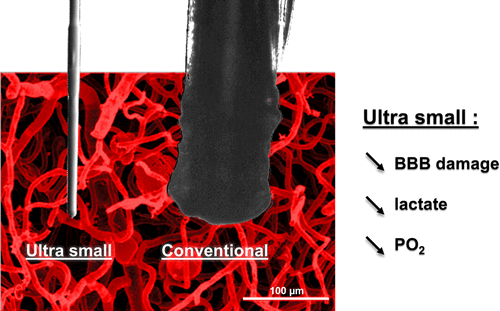当前位置:
X-MOL 学术
›
ACS Cent. Sci.
›
论文详情
Our official English website, www.x-mol.net, welcomes your
feedback! (Note: you will need to create a separate account there.)
Minimally Invasive Microelectrode Biosensors Based on Platinized Carbon Fibers for in Vivo Brain Monitoring
ACS Central Science ( IF 12.7 ) Pub Date : 2018-12-14 00:00:00 , DOI: 10.1021/acscentsci.8b00797 Charles Chatard 1, 2, 3, 4 , Andrei Sabac 3, 5, 6 , Laura Moreno-Velasquez 1, 4 , Anne Meiller 2, 4 , Stephane Marinesco 1, 2, 4
ACS Central Science ( IF 12.7 ) Pub Date : 2018-12-14 00:00:00 , DOI: 10.1021/acscentsci.8b00797 Charles Chatard 1, 2, 3, 4 , Andrei Sabac 3, 5, 6 , Laura Moreno-Velasquez 1, 4 , Anne Meiller 2, 4 , Stephane Marinesco 1, 2, 4
Affiliation

|
The ability to monitor the chemical composition of brain interstitial fluid remains an important challenge in the field of bioanalytical chemistry. In particular, microelectrode biosensors are a promising resource for the detection of neurochemicals in interstitial fluid in both animals and humans. These biosensors can provide second-by-second temporal resolution and enzymatic recognition of virtually any redox or nonredox molecule. However, despite miniaturization of these sensors to 50–250 μm in diameter to avoid vascular and cellular injury, inflammation and foreign-body reactions still occur following their implantation. Here, we fabricated microelectrodes with platinized carbon fibers to create biosensors that have an external diameter that is less than 15 μm. Platinization was achieved with physical vapor deposition, and increased sensitivity to hydrogen peroxide and improved enzymatic detection were observed for these carbon fiber microelectrodes. When these devices were implanted in the brains of rats, no injuries to the parenchyma or brain blood vessels were detected. In addition, these microelectrodes provided different estimates of basal glucose, lactate, and oxygen concentrations compared to conventional biosensors. Induction of spreading depolarization in the cerebral cortex further demonstrated the greater sensitivity of our microelectrodes to dynamic neurochemical changes. Thus, these minimally invasive devices represent a major advance in our ability to analyze brain interstitial fluid.
中文翻译:

基于镀铂碳纤维的微创微电极生物传感器,用于体内大脑监测
监测脑间质液化学成分的能力仍然是生物分析化学领域中的重要挑战。特别地,微电极生物传感器是用于检测动物和人类间质液中神经化学物质的有前途的资源。这些生物传感器可以提供几乎所有的氧化还原或非氧化还原分子的秒级时间分辨率和酶促识别。然而,尽管将这些传感器小型化至直径为50–250μm,以避免血管和细胞损伤,但植入后仍会发生炎症和异物反应。在这里,我们用镀铂碳纤维制造了微电极,以创建外径小于15μm的生物传感器。镀铂是通过物理气相沉积实现的,对于这些碳纤维微电极,观察到对过氧化氢的敏感性增加和酶检测的改善。当将这些装置植入大鼠的脑中时,未检测到实质或脑血管的损伤。此外,与传统的生物传感器相比,这些微电极可提供不同的基础葡萄糖,乳酸和氧浓度估算值。大脑皮层中传播的去极化诱导进一步证明了我们的微电极对动态神经化学变化的敏感性更高。因此,这些微创设备代表了我们分析脑间质液能力的重大进步。未检测到实质或脑血管受伤。此外,与传统的生物传感器相比,这些微电极可提供不同的基础葡萄糖,乳酸和氧浓度估算值。大脑皮层中传播的去极化诱导进一步证明了我们的微电极对动态神经化学变化的敏感性更高。因此,这些微创设备代表了我们分析脑间质液能力的重大进步。未检测到实质或脑血管受伤。此外,与传统的生物传感器相比,这些微电极可提供不同的基础葡萄糖,乳酸和氧浓度估算值。大脑皮层中传播的去极化诱导进一步证明了我们的微电极对动态神经化学变化的敏感性更高。因此,这些微创设备代表了我们分析脑间质液能力的重大进步。大脑皮层中传播的去极化诱导进一步证明了我们的微电极对动态神经化学变化的敏感性更高。因此,这些微创设备代表了我们分析脑间质液能力的重大进步。大脑皮层中传播的去极化诱导进一步证明了我们的微电极对动态神经化学变化的敏感性更高。因此,这些微创设备代表了我们分析脑间质液能力的重大进步。
更新日期:2018-12-14
中文翻译:

基于镀铂碳纤维的微创微电极生物传感器,用于体内大脑监测
监测脑间质液化学成分的能力仍然是生物分析化学领域中的重要挑战。特别地,微电极生物传感器是用于检测动物和人类间质液中神经化学物质的有前途的资源。这些生物传感器可以提供几乎所有的氧化还原或非氧化还原分子的秒级时间分辨率和酶促识别。然而,尽管将这些传感器小型化至直径为50–250μm,以避免血管和细胞损伤,但植入后仍会发生炎症和异物反应。在这里,我们用镀铂碳纤维制造了微电极,以创建外径小于15μm的生物传感器。镀铂是通过物理气相沉积实现的,对于这些碳纤维微电极,观察到对过氧化氢的敏感性增加和酶检测的改善。当将这些装置植入大鼠的脑中时,未检测到实质或脑血管的损伤。此外,与传统的生物传感器相比,这些微电极可提供不同的基础葡萄糖,乳酸和氧浓度估算值。大脑皮层中传播的去极化诱导进一步证明了我们的微电极对动态神经化学变化的敏感性更高。因此,这些微创设备代表了我们分析脑间质液能力的重大进步。未检测到实质或脑血管受伤。此外,与传统的生物传感器相比,这些微电极可提供不同的基础葡萄糖,乳酸和氧浓度估算值。大脑皮层中传播的去极化诱导进一步证明了我们的微电极对动态神经化学变化的敏感性更高。因此,这些微创设备代表了我们分析脑间质液能力的重大进步。未检测到实质或脑血管受伤。此外,与传统的生物传感器相比,这些微电极可提供不同的基础葡萄糖,乳酸和氧浓度估算值。大脑皮层中传播的去极化诱导进一步证明了我们的微电极对动态神经化学变化的敏感性更高。因此,这些微创设备代表了我们分析脑间质液能力的重大进步。大脑皮层中传播的去极化诱导进一步证明了我们的微电极对动态神经化学变化的敏感性更高。因此,这些微创设备代表了我们分析脑间质液能力的重大进步。大脑皮层中传播的去极化诱导进一步证明了我们的微电极对动态神经化学变化的敏感性更高。因此,这些微创设备代表了我们分析脑间质液能力的重大进步。











































 京公网安备 11010802027423号
京公网安备 11010802027423号